I’m not gonna lie—I was scared after agreeing to do Peru’s popular Inca Trail to Machu Picchu hike. More like terrified. I’ve definitely been known to spend a couple hours hiking some trails for the afternoon, though never for 4-days straight or up to elevations that can cause altitude sickness. But, the 26-mile trek is probably the most iconic (or shall I say, bucket list worthy) thing to do in Peru, if not all of South America. Which means, I didn’t want to miss it.
Machu Picchu is undoubtedly a breathtaking destination (it didn’t get the title as one of the new Seven Wonders of the World for nothing!), but adding the beauty of the Classic Inca Trail is like the suspenseful buildup to the grand finale attraction. Its Andean mountain passes are iconic, its steep terrain is brutally challenging, and it was one of the most memorable experiences of my life. And if this out-of-shape, middle-aged chick can do it, so can you.
From training tips to preparing for altitude difficulty to finding the best hiking poles, this insider guide will let you know what to expect along the route and help you to conquer the Inca Trail.
Insider Tips to Conquering Peru’s
Classic Inca Trail to Machu Picchu Hike
WHAT IS THE CLASSIC INCA TRAIL HIKE?
Way back in the 15th century, the Inca people created extensive road networks to make it easier to travel across the region (if you’re interested, you can read more about the Inca history here). This Inca trail system stretches over 25,000 miles—from Peru to Ecuador to Chile and some regions of Argentina and Colombia. The Classic Inca Trail is arguably the most famous part of this network, and for good reason.
The Classic Inca Trail is a 4 day/3 night hike that has you trekking for 26 miles up to altitudes of almost 14,000 feet. Don’t let the seemingly short number of miles fool you—there are over 10,000 stairs along the trail and most of them are uphill (or least it felt like it!). The moderately difficult journey begins at Piskacucho, more commonly known as KM 82, and travels through the Peruvian mountains ending at the iconic Machu Picchu.
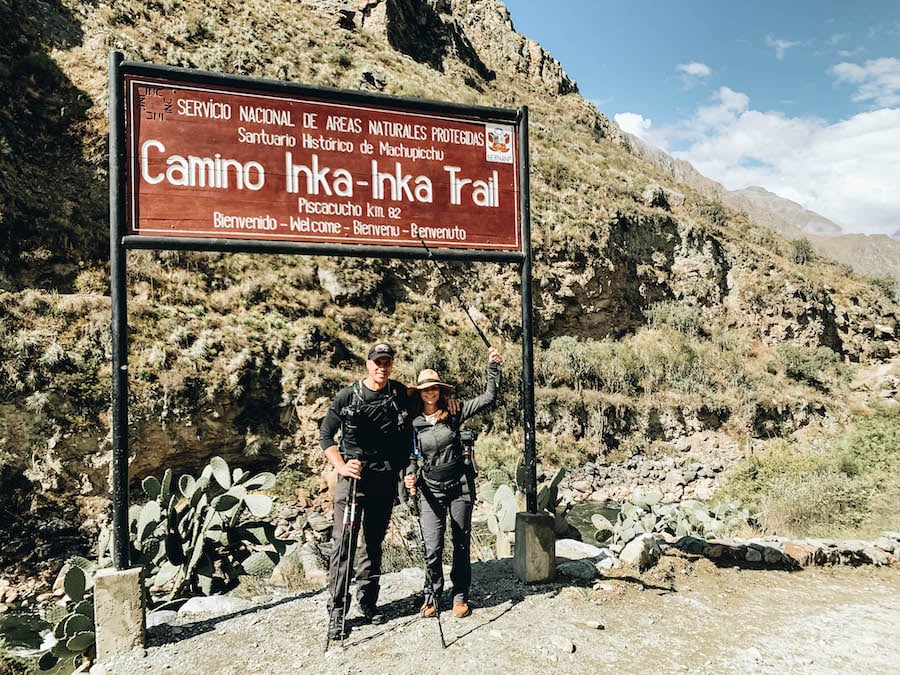
The fear of the difficulty of this hike is what makes most people choose the easier train option to get to Machu Picchu (it’s what almost caused me to do that!), but then you will then be missing out on the treasure trove of natural beauty, a rewarding journey of perseverance, a bonding experience like no other and perfectly-leveled manmade terraces that butt up to desolate ancient ruins.
Machu Picchu will be a jaw-dropping sight no matter how you get there, but I can guarantee that it will mean so much more to you after spending a few days beforehand learning about the history, challenging your body, being rejuvenated with the power of nature and walking the path of the Incans.
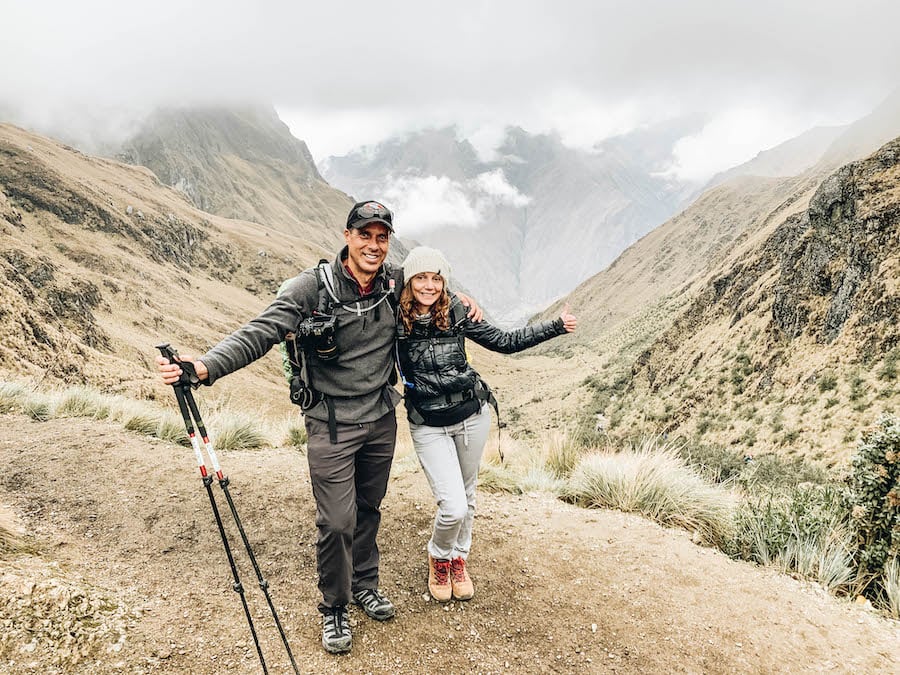
BOOKING AN INCA TRAIL TOUR
You can only do the Classic Inca Trail by booking through a reputable tour company or private certified guide. Choosing the right one is extremely important not only to ensure that you have a great time, but also that you are comfortable and safe in the unknown terrain. We went with Alpaca Expeditions and couldn’t have been happier with their service.
About Alpaca Expeditions
From the highly knowledgeable guides to the yummy multiple course meals high up in the mountains to the comfortable sleeping arrangements, my choice of partnering up with the incredibly caring team at Alpaca Expeditions was a wise one. Here are some other reasons why:
- Alpaca Expeditions is a sustainable company that is dedicated to leaving no trace. They have proper systems in place to ensure that everything is disposed of properly without leaving even a slip of paper behind!
- I don’t know how the chef managed to make such delicious meals in the mountains with no electricity, but he did. We had everything from beef stir fry to guacamole (I’m still dreaming about it!) to tomato and cheese pizza.
- Their equipment is top-notch and in good working order. The sleeping bags were clean and free of tears. The hiking poles were up-to-date and the tents stood perfectly erect with zippers that worked.
- They treat their employees well. After you see how hard the staff works (especially the porters!), you will want to make sure you book a tour company that is fair. Alpaca Expeditions’ employees are paid a reasonable wage, have health insurance and twice a year they invite the porters and their families to Machu Picchu for their first visit ever!
- They have a passion for responsible tourism, and work hard to give back to the community and the land.
- Besides being geek-level knowledgeable, their guides were patient. They knew when to push us and when we were at our limits. Even when I lagged behind they never made me feel embarrassed or rushed.


BOOKING TIPS
Book in Advance
This trek is popular, and due to the limitations of permits you need to book your trip well in advance—we booked about 4 months beforehand. The Inca Trail limits permits to just 500 per day, and that includes tourists, guides and porters. Due to this limitation, you will want to plan well in advance in order to secure your spot.
Can you Hike Solo?
The answer is no. In order to preserve the beauty and purity of the Inca Trail, you must be on a tour group or with a personal guide. For me, a large part of the best memories was from sharing the experience with others in the group, getting their support and conquering it together.
When is the Best Time to Go?
The Dry Season in Peru is from May – October, and the Wet Season from November – April. Choosing between the two depends on if weather or less tourists is more important to you. July and August will see the most tourists, whereas February and March see the most rain (and the Inca Trail is closed for the month of February). May and October are the two best times to go because they miss the peak season, but still offer decent weather. With that said, our hike was in the beginning of September and we couldn’t have asked for better weather. The nights were a little chilly, but during the day was mid-high 60s which made for perfect hiking weather. It only rained for a few of the hiking hours in the entire 4-days.
What Does the Inca Trail Cost?
The Classic Inca Trail trek can range from around $500 to $800, Alpaca Expeditions was $690 which includes 3 meals (plus snacks!), a tent, transportation, two guides and a porter. Keep in mind that a cheaper price isn’t better—it could mean that the equipment is not up to par or that the porters are not being paid fair wages.
Other Trails to Machu Picchu
There are other hikes you can do to get to Machu Picchu, some shorter and some longer (like the Salcantay Route), but the 4-day/3 night Classic is the most popular. You can see all the options here
PACKING
The key word to packing for the Inca Trail is ‘light‘. Though we each had a porter for the trek, they only could carry 7kg of our items (that’s about 15lbs)—that had to include our sleeping bags and air mattress which was about 3kg. That left me with about 8 lbs for the porters to carry and the rest would have to be carried by me in my daypack. Just for reference, my husbands tennis shoes weighed about 2 pounds. Yikes! So packing wisely was essential, bring absolutely no extras unless you don’t mind your daypack being heavier.
Most, if not all, hotels in Cusco will keep your larger suitcases in their luggage storage room while you are hiking the trail. Just make sure that you take your valuables with you, or at the very least use a luggage lock.
The night before your trek you will be given a large green duffel bag to pack for the porters. Either bring a luggage scale with you or weigh your items beforehand at home. Once you get to the starting point of the hike, they will weigh your duffel bag and if it’s even a quarter pound over the limit you will be shuffling items into your daypack because there is no place to leave the items (FYI: I brought a Camebak fourteener daypack and my husband carried the Osprey Stratos 24—both of us were super happy with our choices).
I found Alpaca Expeditions packing list pretty darn accurate.
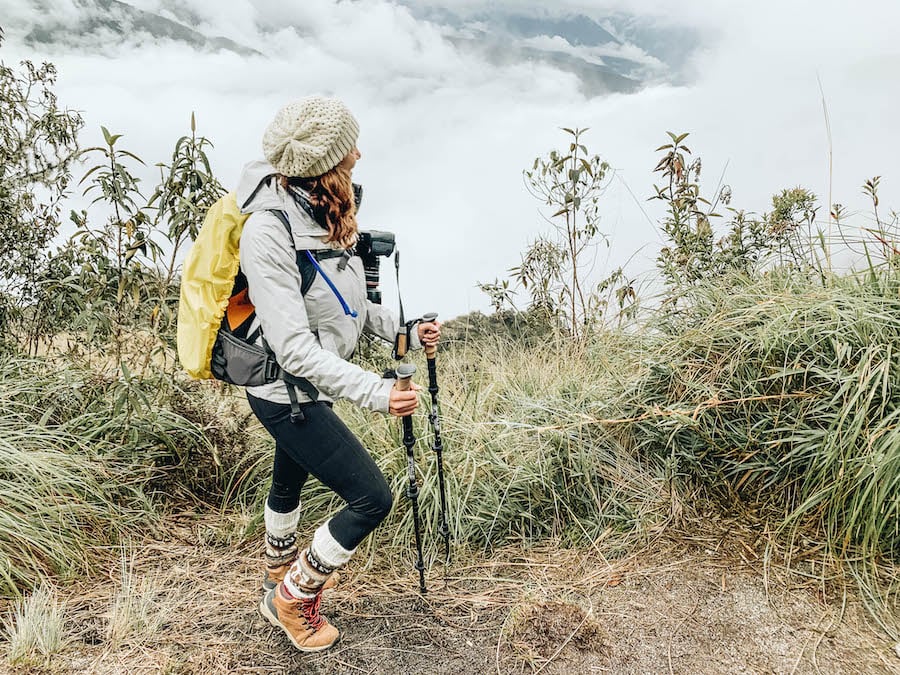
WHAT TO EXPECT FROM HIKING THE INCA TRAIL: MAP & ROUTE
Briefing
The night before the trek we met up with the Alpaca Expedition team to discuss essentials and meet the other hikers in our group. There were 15 of us in total, and the ages ranged from mid 20s – mid 60s (we fell somewhere in between). We were each given a duffel bag for our belongings that the porters would carry. As mentioned before, the total weight could only be 15 pounds, and our sleeping bag and air mattress would be 7 pounds of that. So we could only have the porters carry 8 pounds of our other stuff, the rest would be in our daypacks.
Everybody was given a pickup time, based on the location of their hotel—ours was 4:20am (Yikes!).
Day One: Cusco to Piskacucho Km 82 to Llactapata to Ayapata
Distance: 14 km/approx. 8.5 miles
Starting Altitude: 2720 meters / 8923 feet
Maximum Altitude: 3300 meters / 10829 feet
Elevation Gain: 580 meters / 1906 feet
Approximate Hiking Time: 5 1/2 hours
Difficulty: Moderate—starts fairly flat, but after lunch has a steady climb to campsite
Insider Notes: After pickup from the hotel we drove for about 1 1/2 hours to one of the Porter’s house for breakfast (if you get carsick, take Dramamine beforehand—the roads are windy). There was quite a spread of breads, fruits and even pancakes! So, don’t be worried about being fueled before you begin day one.
After breakfast we headed to Km 82, the start of the trail. This is where we picked up our permits and our duffel bags were weighed—mine was over weight by 1 whole pound! There was no place to leave this extra pound until we were done, so it had to be taken with us. After shuffling stuff from my duffel to
mymy husband’s daypack we were on our way.

The breathtaking views start within 2 minutes of the trek. A river was gushing on one side, as the scenic snow-covered peaks laid in the distance.
Within the first five minutes there was a tiny hill to climb and my heart pumped, which added to the fear. But after that, the trail was fairly flat for the first few hours. However, after breaking for lunch, we realized that the altitude was increasingly gradually, and the effortless hike was turning into a moderately challenging adventure (foreshadowing the difficulty that was in store for day 2!).
Tips for Day One:
- Ask to get a natural tattoo from the red cochineal pigment that can be found on cactus.
- This day is shorter than the next, so take your time and stop for photo opportunities!


Day Two: Dead Woman´s Pass to Runcuraccay Pass to Chaquiccocha
Distance: 16 km/approx. 10 miles
Starting Altitude: 3300 meters / 10829 feet
Maximum Altitude: 4200 meters / 13779 feet
Elevation Gain (Dead Woman’s Pass): 900 meters / 2950 feet
Elevation Gain (Pass 2): 420 meters / 1423 feet
Approximate Hiking Time: 11 hours
Difficulty: Difficult—the uphills are steep and the downhill is just as steep. There are two passes, the first is steep and long, the second is steeper and shorter.
Insider Notes: For months I was calling day two Dreaded Dead Woman’s Pass. It’s the day everyone talks about. It’s the day everyone fears. And for good reason. It will push you to your limit, but it also very well may be the most rewarding day of the trek.
There are two mountains to climb on this day, and the first is an elevation gain of almost 3,000 feet. The hike up this first pass in itself was difficult for me, combine that will the altitude and the challenge was no joke. There was one other guy on our tour struggling with the elevation and we created (and tested) a half dozen different strategies for making it up Dead Woman’s Pass:
- Breath in deep through the nose and out through the mouth
- Walk for 15 seconds, then rest for 15
- Keep the same slow hiking pace not matter if the terrain is steep, flat or downhill
- Take 3 steps, then stop and take 3 breaths
All worked, or at least kept our minds occupied, but the last two were the best for me. The estimated time to the top of the first pass is about four hours, it took me close to six. And I cried at the top out of pride, joy and disbelief. It was a moment that was worth the struggle to get there.


Don’t get too comfortable at the top of Dead Woman’s Pass, because it’ll take about 1 1/2 hours of trekking down steep stairs to get to the bottom. But, it’s not over yet, because there is one more pass before reaching the campsite. Yeah, the second one is a little shorter (2 hours up and 2 hours down), but it was steeper. And halfway in was when I wanted to cry out of exhaustion.
In total it was almost 12 hours before reaching our campsite and it was the hardest physical day I’ve ever had in my life, to the point of feeling nauseous by the end. But, after that dissipated, I had never been so proud of myself for not giving up.
Tips for Day Two:
- This day will be as much psychological as physical, so be mentally prepared.
- You will be excited, and you will be nervous. Use that adrenaline to your advantage.
- Bring a little bottle of liquor in your daypack to celebrate! There will be none at the campsite.
- Don’t worry if you are slower than the rest of the group, go at your own pace. Everyone in our group was so supportive no matter how long it took.

Day Three: Chaquiccocha to Wiñaywayna
Distance: 10 km/approx. 6 miles
Starting Altitude: 3600 meters / 11800 feet
Maximum Altitude: 3680 meters / 12073 feet
Elevation Gain: 80 meters / 273 feet
Elevation Loss: 920 meters / 3008 feet
Approximate Hiking Time: 5 hours
Difficulty: Easy to Moderate—there’s no real elevation gain but lots of downhill stairs!
Insider Notes: After successfully completing Dead Woman’s Pass on Day 2, I woke up feeling quite invincible, but I also woke up with sore wobbly legs. It’s a moderately easy day, but still with over two hours of downhill, so if your legs are challenged it will be a little tricky (hiking poles will help tremendously!).
Along the entire Inca trail trek, day three was my absolute favorite, because of the pure beauty we encountered (and we weren’t even at Machu Picchu yet!). The day was filled with jaw-dropping sites and ruins.
Cloud Forest Trail:
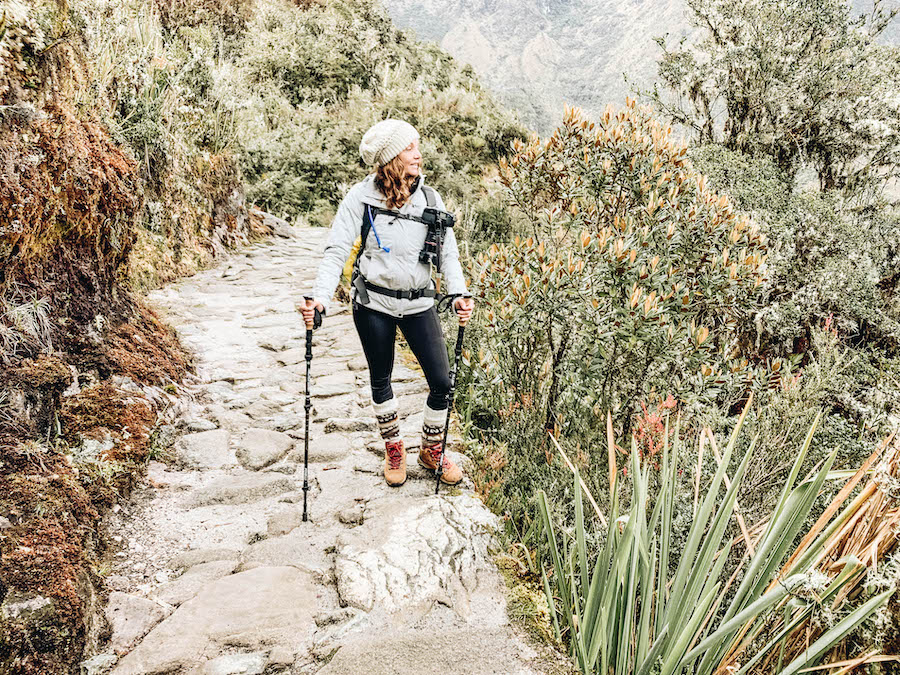
Phuyupatamarka Ruins:

Intipata Ruins:


Wiñay Wayna Ruins (aka: mini Machu Picchu):
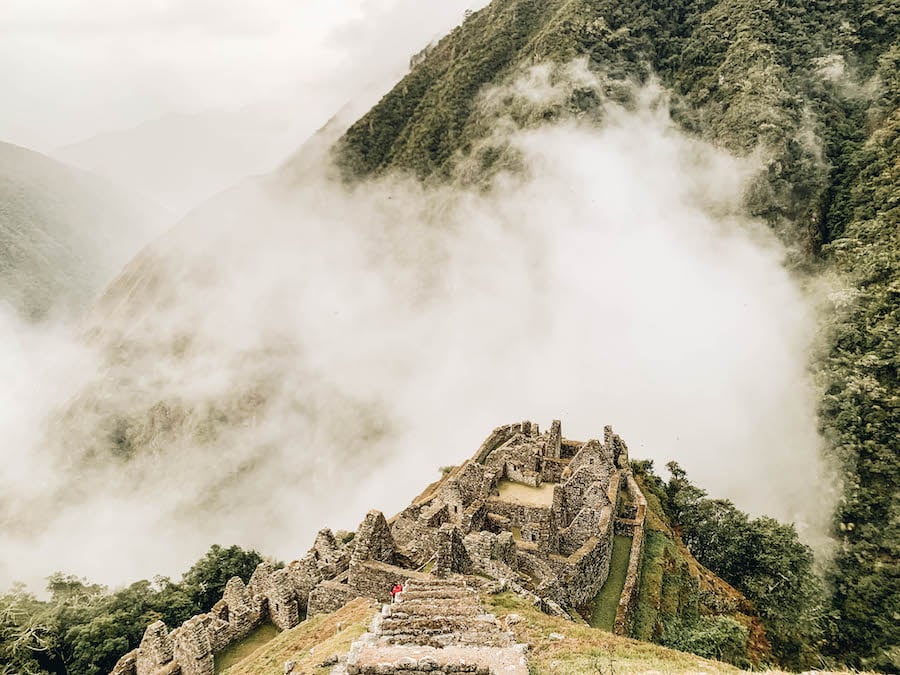
Tip for Day Three:
- Get to sleep early, you’ll be up in the wee hours of the morning (3:20am for us) in order to make it to Machu Picchu early.

Day Four: Sun Gate to Machu Picchu (The Lost City of The Incas)
Distance: 5 km/approx. 2.5 miles
Starting Altitude: 2680 meters / 8792 feet
Maximum Altitude: 2730 meters / 8956 feet
Elevation Gain: 50 meters / 164 feet
Approximate Hiking Time: 2 hours
Difficulty: Easy—easy, except for the spider stairs that are a short set of almost vertical steps!
Insider Notes: We woke up at 3:20 am in order to be one of the first people at the Machu Picchu checkpoint (which didn’t open until 5:00 am), then we waited for the doors to open. Though waking up that early was not my favorite, we were one of the first groups in line with dozens of hikers behind us. The last in line probably wouldn’t get through the checkpoint until about 7:00, whereas we were through by 5:30.
It was a moderately easy two-hour hike alternating between narrow walkways with sheer drops to one side and more stairs. The only tricky part was one flight of stairs that are nicknamed the monkey stairs, and for good reason—they are nearly vertical with some trekker needing to climb it using both their hands and feet.
After two hours we reached the pinnacle of this hike, Machu Picchu. It was covered in clouds when we arrived and I couldn’t help but think, “what the heck did I just hike 26 miles for?” But, we just waited a few minutes and the clouds changed, allowing the Lost City of the Incas to peek through.


Tips for Day Four:
- Don’t worry about rushing to Machu Picchu, you will not be the first ones there. Tourists who take the train to the city of Aguas Calientes, and then spend the night, will easily be able to enter before you reach the entrance.
- If it’s cloudy, be patient. Many times the cloud formations will change within a few minutes.
- Bring your passport so you can get the Machu Picchu stamp. There is a stamping station right before the entrance (you do the stamping yourself).
- Once in Machu Picchu you will follow a path that goes in one direction (to avoid congestion), so make sure you get your photo the first time through!

FACILITIES, MEALS & CAMPSITES
Naturally a four day journey into the wild will have you worrying about the quality of food and accommodation you will to endure, particularly the toilets. Here’s what you need to know.
Campsite
The campsites each night were all slightly different, though the similarity was that they all had a couple rows of sleeping tents and a dining tent. The porters carried and set up these tents prior to our arrival, and packed them up in the morning (yay to them!). The interiors were pretty roomy, fitting two sleeping bags with at least a foot or two of room on each side for our personal items.
Each morning our wakeup call was done by a porter (or two) offering a cup of coca tea and a small tub of hot water for bathing.
Campsite Tips:
- Bring a pair of flip flops that can be worn with socks for walking around camp.
- You can bring your own sleeping bag, but it’s easy enough to rent one from Alpaca Expeditions for $20. They are mummy style sleeping bags that are usable in -15° C / 5° F. Freshly washed liners are provided to everyone, but we still brought our own Vumos silk-like liners.
- A foam mat is included, but consider renting an air mattress for $15. We rented them and it was really cushy!
- Nights can be chilly, so put your clothes for the next day in your sleeping bag. They will be warm in the morning when you put them on.

Restrooms/Toilets & Showers
The restrooms on the trail will be anything from barely mediocre gas station quality to porta potty to a less desirable squat toilet. In all honesty, sometimes you will just prefer to pee in the woods. Some campsites were equipped with an onsite restroom facility with flushing toilets (a luxury on the trail!) while others required Alpaca Expeditions to set up their own private toilet tents that they placed in a discreet location.
There was only one opportunity to shower on the trail, on day three, though most trekkers (myself included) opted not to because the water was freezing cold!
Toilet & Shower Tips:
- Carry a bottle of sanitizer with you, most toilets do not have soap or running water.
- Bring your own toilet tissues. These small Kleenex packs worked great for me.
- If you’re not a cold shower kind of person, bring shower wipes with you. My husband bought them at the last minute and I am so grateful he did!
Meals
Three full meals, plus snacks for the trail, are included in the cost of the tour. From fluffy pancakes to mushroom ceviche with sweet potatoes to baked beef with a vegetable stir-fry, you will be surprised what the chef can do! And I promise you that you will not be hungry. There was always plenty of food and a wide variety for those picky eaters. The kitchen team also took extra care to cater to any special requests, allergies, and preferences. Our Alpaca Expeditions chef even made one of our team members a birthday cake because it was her 40th (what a bucket list worthy way to spend your birthday!).
There was a happy hour every evening, minus the alcohol (unless you brought your own). The hour consisted of hot tea, coffee, juice and snacks. It was a great time to talk to the group about the experiences of the day, but everyone really loved this happy hour mostly because of the freshly made popcorn that was served!


Safe Drinking Water
Besides the first morning, when you have to fill your own hydration bladder before hitting the trail, the Alpaca team provided safe drinking water with every meal and for carrying on the hike. If you want to be extra cautious, you could get water purification tablets, though no one in our group had any problems with drinking the water provided.
Internet
The Inca Trail is the perfect opportunity to totally disconnect from technology and connect with nature, because there is no internet. I received faint cell service for the first few hours and at two of the ruins on day three. But, definitely don’t plan on it. In case of emergency, the tour company carries a satellite phone at all times.
HOW HARD IS THE CLASSIC INCA TRAIL?
I can’t tell you how many blog posts I read about the difficulty of this trek—3 would terrify me, then one would give me a glimmer of hope and then back to being terrified again. You know how when you’re sick and you want to google your symptoms and everybody tells you “don’t do that!”. That’s kind of how I feel about searching “how hard is the Inca trail”. But after actually completing the trail, here’s what I’ve learned.
How fit do I have to be?
The Inca Trail is described as a moderately challenging trail, and it is highly recommended for people who have experience with some long distance hikes with substantial elevation gains.
You do not have to be a seasoned backpacker or an expert hiker to successfully finish and enjoy the Inca Trail, however, it is important to be physically fit. The greatest difficulty that a non-fit individual would face is the continuous walking, steep inclines and manipulating the 10,000+ stairs. With that said, even the fittest hikers could be effected by the altitude. So, your training should include stairs and some sort of cardio.
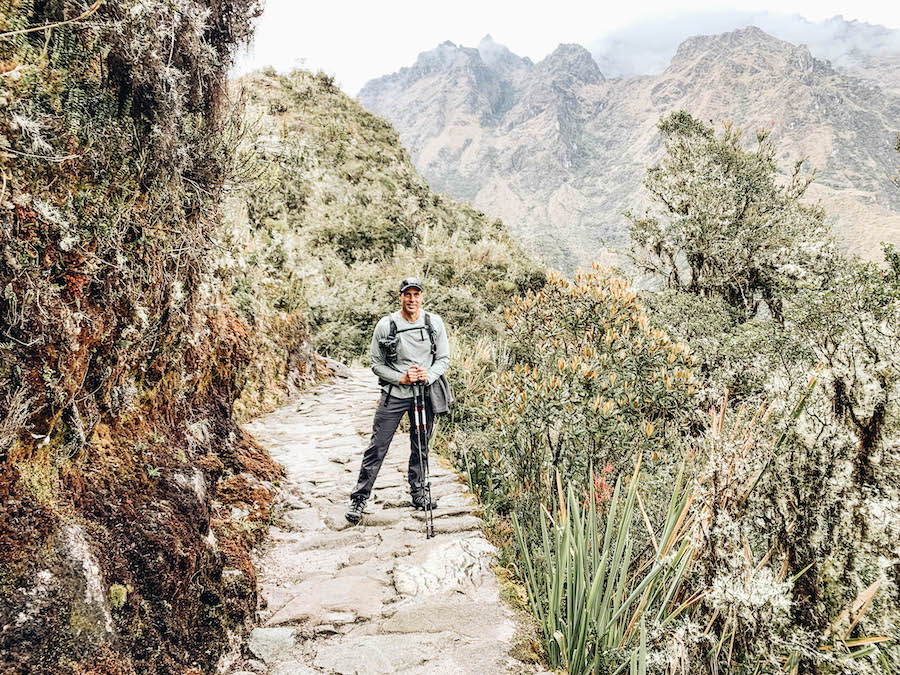
How did I Train & Was it Enough?
Let me be honest, I don’t like to work out—at least not in the traditional sense of going to the gym. I’m not in great shape. I actually quit my gym membership two months before this hike (why did I need it when I never went!). I don’t work out, instead I travel. I know, not the same thing. But, it does require being active and lots of walking, but definitely not climbing uphill for five hours straight. That’s why this hike scared the bejesus out of me. I was traveling most of the time for a few months before heading to Peru, so tried to walk as much as possible (about 15,000 steps per day) and take the stairs instead of elevators or escalators.
With two and a half weeks back home before heading to Peru, I went on a 4-day per week binge exercise program. Here’s what I did:
- Instead of using a cart, I walked the golf course while playing 9-holes (it’s super hilly).
- I walked up and down the stairs of my house, two at a time, about a dozen times per day.
- My girlfriend and I made it a goal to hike every trail at our local state park (and did it!).
- I walked to and from the restaurant my husband and I own (about 1.5 miles each way).
That’s it. I was nowhere near as prepared as I wanted to be. I wish I had started training the recommended 2-3 months in advance. But, was it enough? Well, I completed it. So, ultimately yes.
Hiking Poles: Yes or No?
Yes. That is a strong affirmative yes! I don’t think I would have finished the trail without them. They take a little of the the pressure off your legs and knees, especially when going downhill. On day three, when my legs were so incredibly sore after completing Dead Woman’s Pass, they were a necessity!
There were a couple of very fit men who did the entire thing without them, so it is possible, but I wouldn’t take the chance. You can rent them from the company for $15, but I bought these Foxelli Trekking Poles beforehand and am happy to have them for future hiking.


Preventing Altitude Sickness
One of the best things you can do before hiking the Inca Trail to Machu Picchu is to try to acclimate in Cusco beforehand. Cusco has an elevation of 11,152, whereas Machu Picchu sits at 7,972 and the highest point of the trail is 13,779 (that’s way the heck up there!). We arrived in Cusco the recommended two days early in order to try to acclimate to the altitude, but I honestly felt like one or two more days would have been better. This is probably because we came from an area in northern California which is at sea level. If you’re from someplace with some altitude already, like Colorado, then the two days may be enough.
It is also important to equip yourself with the necessary medical supplies, herbs, and remedies. Though I didn’t use it, many were taking the altitude sickness medicine Diamox, which is extremely popular amongst hikers. In addition to that, the locals believe in a time-tested natural remedy that has been useful for the Inca people for over a hundred years. It requires you to chew on some Coca leaves or brew them in a cup of tea, which you can either buy in Cusco or along the trail at some stops. Just be aware that coca leaves are the raw materials used for making cocaine. Though it doesn’t give you the cocaine high, you may test positive for cocaine. I drank at least a cup of tea every day, but it didn’t seem to have any effect on me whatsoever.
Signs of Altitude Sickness
Many people suffer altitude sickness of some sort, but most cases are mild. The most common are dizziness, headaches and getting winded more quickly. Some more severe symptoms would be vomiting and diarrhea. For me, it was shortness of breath and a rapid heart rate while trekking uphill. I just had to adjust my pace, taking my time and not worrying about how slow I was going.
Your guides will be well trained in dealing with altitude sickness, so just keep them posted along the way. With that said, we had 15 people in our group and not one experienced anything too severe.
Training Tips:
- Cardio, cardio, cardio. This was one area that I didn’t focus on during my pseudo-training and it was the most challenging for me.
- Completing the trail is just as much a physical challenge as it is a mental one, so be mentally prepared to motivate yourself.
- Start 2-3 months before your trek.
- If you’re really worried they make altitude training mask to maximize your workouts.
Keep in mind, that you are not the only one struggling, others in the group will be too. Even if you are lagging behind everyone else, the group and the guides will be rooting you on and the bond you will form with these people will be incredible.

Extra Essential Tips to Hiking the Inca Trail to Machu Picchu
How Much Money to Bring: I was in Peru for a total of 7 days. I brought 1500 Peruvian soles ($450 USD) and an extra $250 USD with me, in addition to a credit card that I used only in Cusco. On the Inca Trail you will only need money for the drink/snack vendors on the first few days and for tipping.
Tipping Porters, Guides & Chef: In addition to the cost of the tour, tipping is something else to consider budgeting for. It is on a voluntary basis, but once you see the backpacks the porters are carrying and how well all the staff treats you, you will want to make sure that they are taken care of. Here’s what Alpaca Expeditions says about tipping:
“Tipping is of course 100% voluntary and should only be done if you feel like your guide, porters and chef have done an amazing job for you. Of course we hope every trip we lead is exceptional, so if you do choose to give a tip, we have some general guidelines on how much to give. Generally groups give collective tips that are shared between the cook and all porters including the head porter and is usually given on the last night of the trek. If the group pools together money and at the end each porter receives 60 soles and your cook receives double that, 120 soles, they will end with a great tip. Often, the tip for your guide is done personally and is generally 50 soles per traveller.”
My husband and I tipped as a couple. We put 220 soles ($66 USD) in the group pool for the porters (there were 15 of us and 21 of them, so each porter would receive about 78 soles), 120 soles ($36 USD ) for the group pool for the chef, our guide $80 USD and the assistant guide $60 USD. For a total of $242 in tips for the two of us.
Tipping the guides in USD was fine, but we were told that for the porters and chefs it was better in soles.
More Tips:
- Bring your own alcohol: Though it is not recommended to drink alcohol at high altitudes, just an FYI that if you’d like to celebrate with some alcohol, bring alcohol. The first couple days of the hike you can buy a beer (or two) from vendors along the trail, but the next couple of days there are no vendors in sight.
- Break in your footwear: The trail is no place to be breaking in your hiking boots. Make sure to wear them for 4-6 weeks beforehand to limit blisters. Just in case, bring some blister tape with you. I brought a few strips of Rocktape and had to use it!
- Extra batteries: There are no charging stations along the trail, so make sure to bring enough battery backups. I used the Apple Smart Battery Case for my Iphone along with two Anker Battery Backups, and for my Canon 6d I brought two charged batteries. It was plenty.
The 4-day Classic Inca Trail hike to Machu Picchu was certainly not easy to say the least, but that was the entire point: to challenge myself by pushing my comfort zone. It was hard, but it was also one of the most rewarding and memorable experiences of my life.
Essential Tips for Visiting Cusco, Peru
Getting There: The Alejandro Velasco Astete International Airport, is a major hub and most airlines will fly into it. However, most international travelers visiting Cusco will have to fly to Cusco by way of Lima. You can easily check for the best fare deals at Skyscanner, which also has the option to choose ‘cheapest month’ as the departure to find the lowest priced dates to fly to your destination. From the airport to the city center, you can use an Uber, an official airport taxi (Llama Taxis) for about 35 Soles, or un-official taxis for 10-15 Soles, although you would have to barter to get the right price as the drivers will start by offering a price of 25 – 30 Soles. If you choose to use an un-official taxi, be sure to agree on a price before hopping into the car.
Where to Stay in Cusco: It’s best to stay near the city center, public transportation or the area that you will be spending the most time in. Hotel Rumi Punku is a great choice in Cusco’s city center. For something on the less expensive side, try the MOAF Cusco Boutique Hotel located in the heart of Cusco. For a hotel with a little more extravagance, book a room at the Antigua Casona San Blas. Or search some great deals on hotels of your choice at Booking.com. If you’re looking for more of a home atmosphere (or are traveling with a group of people), head over to Airbnb that has houses, apartments and even just a room for rent in every price range.
Getting Around: Driving in Cusco can be a bit of a challenge and parking fees can be expensive, but if you choose to rent a car, DiscoverCars.com has great deals. If you are not renting a car, there are plenty of options. The best way to get around Cusco is by foot. Buses, taxis and Uber are available all over the city.
Best Tours in Cusco: You can find some of the top tours at Get Your Guide or Viator, and here are some of the top ones:
Insurance: It’s always a good idea to travel fully insured so you are protected in case of trip cancellations or medical emergencies. You can check out pricing at Travelex Insurance.
Universal Adapter: Your American plugged equipment will need an adapter. I use the Celtic Universal Adapter, which has brought me around the world with no problems.
This post may contain affiliate links. If you make a purchase through my links, I earn a commission that helps to keep this blog running—at no extra cost to you. For more information read my full disclosure.
Save this Post to Pinterest for Later

You Might Also Enjoy
Cartagena Colombia Bucket List: 42 Top Things to Do
Cusco Peru Bucket List: 30+ Things to Do in Machu Picchu’s Gateway City
A Guide to Piranha Fishing (& Eating) in the South American Rainforest
Hiking Bucket List: 25 Best Hikes & Backpacking Treks in the World
Amazon Jungle Travel: 45 Things to Pack for the Rainforest
Guyana’s Kaieteur Falls: One of South America’s Best Waterfalls


